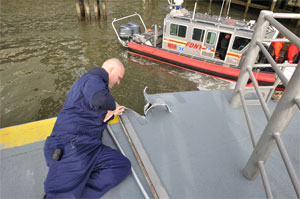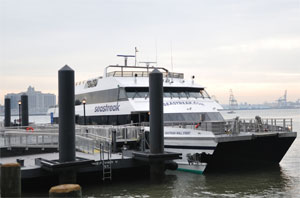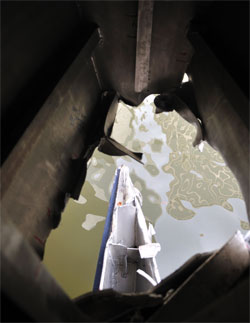The National Transportation Safety Board and U.S. Coast Guard are investigating why a high-speed ferry crashed into a New York City pier, injuring 85 people.
The twin-hulled aluminum Seastreak Wall Street struck Manhattan’s Pier 11 in the East River on Jan. 9. Its captain told investigators he tried to reverse the engines but got no response.
One passenger was seriously injured while 83 passengers and a deck hand suffered minor injuries. The vessel struck the pier at 12 knots, according to the NTSB preliminary report. The impact punched a hole in the starboard bow.
 |
|
Coast Guard Chief Warrant Officer Aaron Brawner inspects damage to the hull.
A view through the holed bow. |
The 131-foot ferry departed Atlantic Highlands, N.J., at 0802 with 326 passengers and five crewmembers on board for its second trip of the day, the report said. The accident occurred at 0841. As the vessel approached Pier 11, the master reduced speed from 30 knots to 12 and prepared to dock starboard side to.
“To obtain better visibility of the dock and his crew handling lines, the master transferred propulsion control from the vessel’s center console operating station to the starboard bridge wing station, about 10 feet away,” NTSB said. “He told investigators that he then walked over to the starboard console and attempted to take control there, but that the thrust controls did not respond. He returned to the center console with the belief that the transfer had been unsuccessful, but at that point the center console thrust controls did not respond either. He immediately returned to the starboard console and repeated his attempt to gain control.”
The impact came shortly after that. The captain said he did not have time to issue a warning to the passengers or crew over the public address system or sound the danger signal.
The impact stalled the two main engines but the master instructed a crewmember to restart them, which he did successfully. The master was able to restore propulsion control and maneuvered to nearby Slip B for docking. First responders boarded there and transported the injured to hospitals.
Besides the damage to the bow, an interior window at the bottom of a staircase was broken as were two windows on doors leading from the upper passenger accommodation area to the aft deck. The port-side propeller was fouled with debris. Damage assessments are pending. Because of the fouling of the propeller, the U.S. Army Corps of Engineers completed an initial underwater survey of the approach to Pier 11. The results have not been made public.
Seastreak Wall Street was constructed with waterjet propulsion, but in February 2012 it underwent modifications to its main engines and propulsion system. The four main engines were removed and replaced with two MTU Friedrichshafen GmbH diesel engines in service at the time of the accident. The waterjets were replaced with Servogear AS controllable pitch propellers, and new Scana Mar-el AS helm controls were installed in the wheelhouse. The Coast Guard inspected the vessel before it returned to service, issuing a temporary certificate of inspection July 24, 2012.
Tom Wynne, attorney for the vessel owner, Seastreak LLC, said “the NTSB has asked that we not talk about the incident or the investigation. We have tried our best to cooperate with them fully.” He added that investigators spent more than a week at the company’s facility. “We have to wait for their report before we can talk about it,” he said.
Wynne did say that “we had 326 people on board and we’ve attempted to reach out to each one of them and deal directly with them and to the extent that they have claims for medical care for lost work or had property damage we’re working to try to resolve them.”
In an accident such as this, potential factors may include damage to a propeller or propulsion equipment or a problem with switching the consoles, said passenger vessel safety consultant Clark Dodge, former chief engineer for the Washington State Ferries system.
“If there was damage to one of the propellers and the propulsion system was working properly, then the boat should have pivoted or at least been able to back down and operate correctly with the other propeller,” said Dodge, who does not have firsthand knowledge of this accident.
He said without having access to the full analysis of the investigators, it’s impossible to tell “if somebody had a switch in the wrong place or the system locked up.”
Seastreak Wall Street was involved in two other accidents since 2009, according to Coast Guard records. On Aug. 12, 2009, while docking at East 35th Street, the starboard bow received a two-foot to three-foot tear about six to seven feet above the waterline. On Jan. 29, 2010, Seastreak hit a cluster of fender piles while docking. No injuries were reported in either incident.


